
Everyone enjoyed last night’s party for Vincent’s graduation. The food was plentiful, delicious, and catered by “We Cater to You,” a local company that may be found here at this site.
They did an excellent job preparing (and cleaning up) beautifully presented food that included the typical taco fixings, bags of chips, a fruit salad, and a colorful green salad with blackberries that I topped with the chicken taco meat, which was perfect for me.
There were party gifts, root beer on tap, canned beer for the adults, and plenty of added decor to highlight the graduation theme. Most likely, about 60 people joined in on the festivities, including several Lyman family members, Vincent’s birth dad and family, and other family friends.

Minnesota’s notorious barrage of mosquitos attacked me a few times, but when I didn’t have to be concerned about malaria, I didn’t think about it much. I wore socks to protect my vulnerable ankles, long pants, and a shirt with sleeves. Alas, the nasty little buggers bit my hands, my only exposed skin.
We arrived promptly at 5:00 and headed out around 8:30 to return to our hotel to spend the remainder of the evening relaxing before retiring for the night. I awoke at 5:00 am to the sound of hotel room doors slamming as guests were checking out, stayed awake for about an hour, and finally drifted off again, somehow managing to sleep through a lot more noise in the corridor, which continues now as I write here.
Getting back to food trends from the past decade, here are the remaining items from the story we started yesterday for Part 2:
Latte art made a splash as coffee culture intensified. Latte art, or art made using espresso, steamed milk, and frothed milk to create images in foam, took over social media for a spell in the mid-2010s.

Hard seltzer will go down as one of the biggest trends of the 2010s, with consumers flocking to the lower-calorie boozy beverage. The summer of 2019 was the summer of hard seltzer. The boozy beverage was so beloved that there was even a national shortage of White Claw, the most popular hard seltzer brand.


A juicing machine churns out some kiwi-lemon juice. Shutterstock. Not our photo.


Founder’s All Day IPA, a low-ABV session beer. Founders. Not our photo.
Photo from ten years ago today, June 8, 2014:

